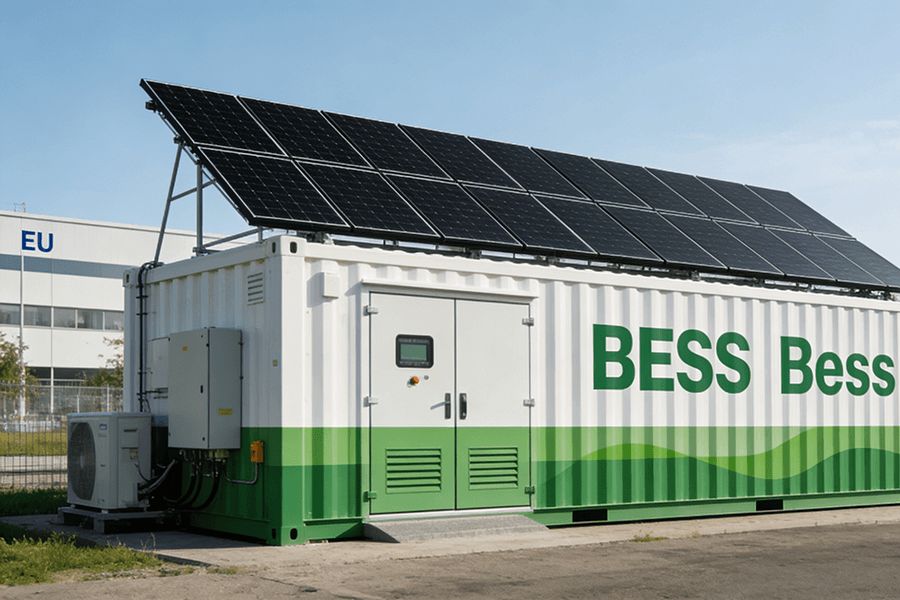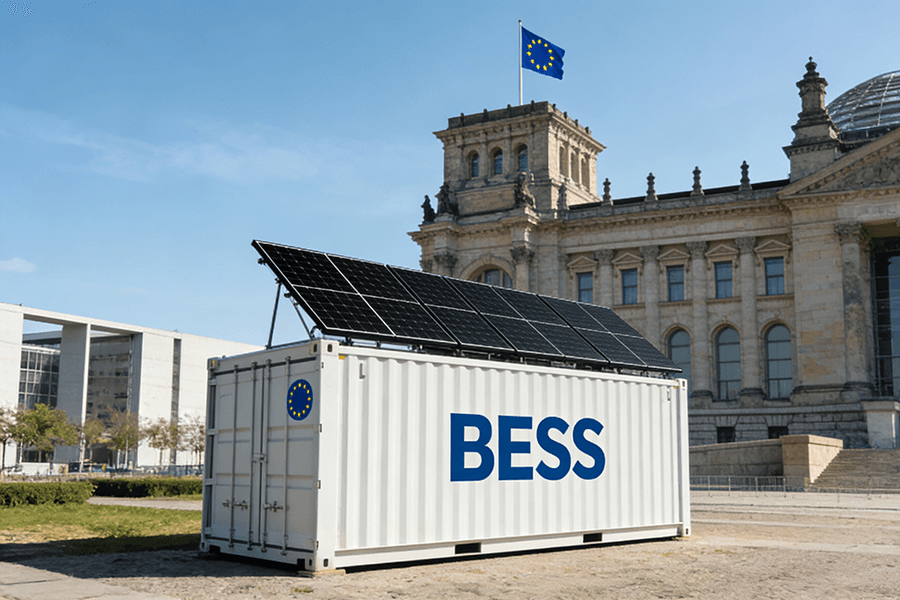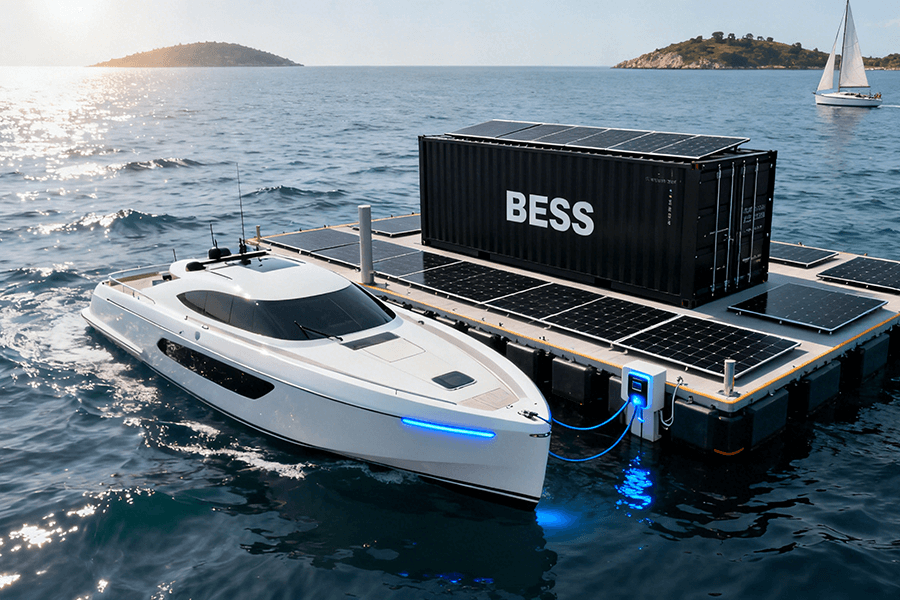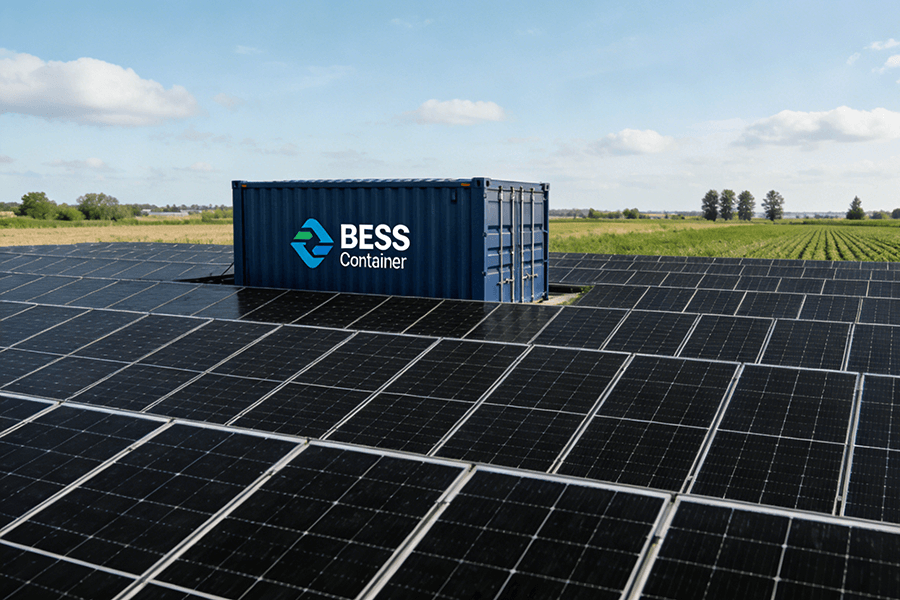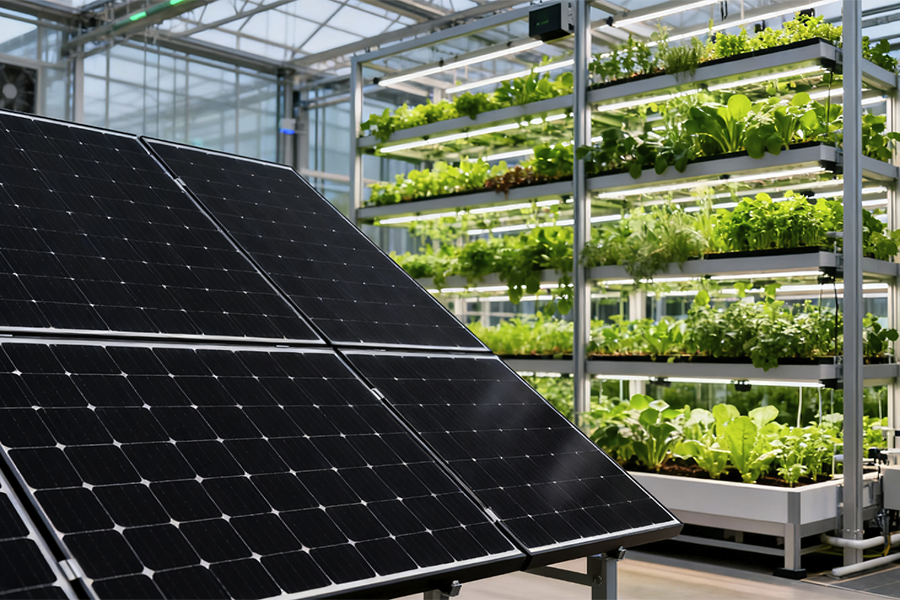
The Boom (and Energy Headache) of European Vertical Farming
European vertical farms are sprouting faster than lettuce in a well-lit grow tray. The continent is witnessing a green revolution, with data from industry reports¹ indicating that by 2030, the market is projected to reach a staggering €5 billion. This growth is evident in the landscape, where over 300 large-scale vertical farming facilities are expected to dot the map, transforming urban skylines into hubs of agricultural innovation.
However, this rapid expansion comes with a significant challenge: energy consumption. These high-tech farms are energy-intensive, consuming 5-10 times more power per square meter than traditional fields¹.
To put this into perspective, consider a 10,000 m² vertical farm dedicated to growing romaine lettuce:
- Such a facility typically devours approximately ~90,000 kWh of electricity every month³
- Without effective energy management, the annual energy bill for this single farm could skyrocket to €1.08 million³
- Electricity accounts for a substantial 40-70% of vertical farming operational costs³
The culprits behind this high energy demand are the essential systems that sustain crop growth:
- LED lights: Simulate natural sunlight and operate 24/7 to control plant growth cycles
- Hydroponic pumps: Continuously deliver vital nutrients to plant roots
- Climate control systems: Maintain a constant 22°C for optimal growing conditions
These critical components require a constant and reliable power supply—any interruption risks crop loss.
Enter BESS containers—the unsung heroes of the vertical farming industry. These Battery Energy Storage Systems act as the farm’s energy bodyguard, providing:
- Quiet operation
- Reliable backup during grid outages or fluctuations
- Cost savings potential
By ensuring continuous operation of LED lights, pumps, and climate control, BESS containers safeguard productivity and make vertical farming a more sustainable and economically viable venture in the long run.
Core Roles of BESS Containers: Your Farm’s Energy Lifesavers
Stabilizing Power: No More “Oops, We Lost the Crops” Moments
Vertical farms operate in a delicate equilibrium where power stability isn’t just a convenience—it’s a matter of survival for the crops. These indoor agricultural ecosystems are as finicky as divas when it comes to electricity. Even a mere 1-hour outage can disrupt the carefully calibrated growth cycles, stunting plant development or, in the worst cases, turning lush, fresh greens into worthless compost. This is where Battery Energy Storage System (BESS) containers step in as the unsung heroes, eliminating downtime and acting as a seamless backup for critical systems.
Consider the essential components of a vertical farm:
- LED grow lights are the lifeblood, providing plants with the consistent 24-hour light cycle they need to thrive, much like how humans rely on their daily dose of coffee to function.
- Hydroponic pumps, on the other hand, serve as the crop’s personal room service, meticulously delivering water and nutrients on a precisely scheduled basis.
A Berlin-based vertical farm experienced this vulnerability firsthand, narrowly avoiding disaster. During a 4-hour grid outage, its 800kWh BESS container automatically activated, stepping in to power the essential systems and saving €50,000 worth of lettuce from an untimely end as bird feed¹.
The impact of power outages on vertical farms can be staggering, both in terms of crop loss and financial implications. The following table illustrates the severity of these consequences based on outage duration, alongside the corresponding BESS solutions:
| Outage Duration | Crop Impact | Typical Financial Loss (1,000 m² Farm) | BESS Solution |
|---|---|---|---|
| 1 hour | Stunted growth; delayed harvest | €12,500 | Instant backup (0 downtime) |
| 4 hours | Partial crop loss; 30% yield drop | €50,000 | 800kWh+ BESS unit |
| 12+ hours | Total crop failure; 6-month recovery | €150,000+ | 2MWh+ BESS system |
Slashing Costs: Peak Shaving + Negative Price Arbitrage
The European electricity market is notorious for its volatility, with prices fluctuating wildly throughout the day. Rates can soar to a steep €0.40/kWh during daytime peaks, when demand is high, and plummet to surprisingly low levels, even dipping into negative territory at night⁴. Vertical farms, with their constant and substantial energy requirements, often find themselves bearing the brunt of these price spikes, with peaks adding up to 30% to their energy bills¹. Fortunately, BESS containers offer two ingenious strategies for significant cost savings.
Peak Shaving: Beat the Daytime Price Spike
BESS containers leverage the off-peak electricity rates by charging up during the night when prices are at their lowest (averaging around €0.15/kWh). These charged batteries then power the farm during the daytime peak hours when grid electricity is most expensive (€0.40/kWh).
A prime example is a Rotterdam vertical farm equipped with a 1.5MWh BESS container, which achieved remarkable savings of €120,000 in its first year—a sum equivalent to the cost of 12,000 bags of organic fertilizer¹.
For a more detailed understanding, here’s a breakdown of the annual savings achievable with a 1MWh BESS:
- Nighttime charging cost: €0.15/kWh × 1,000 kWh = €150/day
- Daytime grid cost avoided: €0.40/kWh × 1,000 kWh = €400/day
- Daily savings: €400 – €150 = €250
- Annual savings: €250 × 365 = €91,250
Negative Price Arbitrage: Get Paid to Charge
The phenomenon of negative electricity prices is becoming increasingly common in Europe. In 2024:
- Germany recorded 468 hours of negative electricity prices, a 60% increase year-over-year.
- Finland witnessed over 700 hours of such instances⁴.
During these periods, grid operators pay users to consume electricity, essentially paying them to charge their batteries. BESS containers take full advantage of these opportunities, turning a traditionally costly activity into a revenue-generating one. For instance, a Hamburg farm with a 2MWh BESS capitalized on these negative price windows, earning €3,200 in 2024 solely from charging during these opportune moments¹.
BESS + Renewables: The Dynamic Duo for Sustainable Farming
In 2024, the European Union achieved a remarkable milestone with renewable energy accounting for a record 48% of its electricity generation¹. However, the intermittent nature of solar and wind power sources, influenced by factors such as cloud cover, wind lulls, and nighttime darkness, poses significant challenges. This is where Battery Energy Storage System (BESS) containers play a crucial role, converting the inherent unpredictability of these renewable sources into a reliable energy supply.
Solar-Storage Synergy: Capture Sunlight for Rainy Days
Rooftop solar panels have become a staple feature on many vertical farms, capitalizing on available space to generate clean energy. Yet, their operation is inherently limited by the diurnal cycle, ceasing to produce electricity once the sun sets. BESS containers address this limitation by storing excess solar power generated during the day. This stored energy can then be utilized during nighttime hours, effectively transforming daytime sunlight into a continuous source of nighttime energy.
A prime example of this synergy can be seen in a Parisian vertical farm, which integrated a 2MW solar system with a 2MWh BESS container. This setup resulted in an impressive 55% renewable energy utilization rate and a 40% reduction in carbon emissions¹. To put this reduction into perspective, it is equivalent to removing 100 cars from the road each year. For agrivoltaic projects, which combine agriculture and photovoltaics, BESS is an essential component. It plays a pivotal role in helping the EU achieve its ambitious target of 10GW of agrivoltaic capacity by 2030².
| Key Metrics | Paris Vertical Farm |
|---|---|
| Solar System Capacity | 2MW |
| BESS Container Capacity | 2MWh |
| Renewable Energy Utilization | 55% |
| Carbon Emission Reduction | 40% |
Wind-Storage Compatibility: Tame the Wind’s Whims
Rural vertical farms often find wind power an attractive energy source due to its abundance in open areas. However, the erratic nature of wind—fluctuating between powerful gusts and calm lulls—makes it an unreliable standalone option. A Swedish vertical farm demonstrated an effective solution by installing a 1MW wind turbine in conjunction with a 1.2MWh BESS container¹. During periods of high wind activity, excess power generated by the turbine is stored in the BESS container. Conversely, when wind speeds drop, the stored energy is released to maintain a consistent power supply.
Denmark’s Nordic Harvest, Europe’s largest vertical farm, has taken this concept to the next level. Operating entirely on wind power, supplemented by BESS backups, the farm produces 1,100 tons of carbon-neutral greens annually⁴. This achievement not only showcases the viability of relying solely on wind energy for large-scale vertical farming but also underscores the indispensable role of BESS in ensuring energy security. Clearly, the combination of wind power and BESS represents a winning formula for sustainable agriculture.
Innovation & Policy: AI, Grants, and Why BESS Is a No-Brainer
AI-Driven Optimization: BESS Gets a Brain Upgrade
In the vanguard of vertical farming innovation, Battery Energy Storage System (BESS) containers have transcended their traditional role as simple energy storage units. Through the integration of Artificial Intelligence (AI), these systems have evolved into intelligent energy management powerhouses.
AI algorithms meticulously analyze the growth stages of crops, from the delicate seedling phase to the bountiful harvest period, and dynamically adjust power allocation in real-time. During non-critical growth phases, lighting systems are dimmed to conserve energy, while surplus energy generated during peak wind or solar production is captured and stored. This sophisticated approach has been proven to enhance overall energy efficiency by up to 15%¹.
The practical impact of this technology is evident in real-world applications:
- London Vertical Farm: A leading vertical farm in London implemented AI-driven BESS optimization, achieving a remarkable 10% increase in crop yields while simultaneously reducing energy consumption by 8%¹.
- EasyFlow Startup: The innovative startup EasyFlow has pushed the boundaries even further. By synchronizing BESS operations with the natural circadian rhythms of plants, EasyFlow’s AI system has demonstrated the potential to cut energy usage by up to 27%³. This advancement is comparable to having a dedicated energy management expert overseeing every aspect of the farm’s power consumption.
EU Grants: Get Paid to Go Green
The European Union (EU) is actively incentivizing the adoption of sustainable technologies in vertical farming through a series of robust financial support programs. BESS-equipped vertical farms can take advantage of these initiatives to offset implementation costs and accelerate their transition to renewable energy sources.
Here’s a detailed breakdown of the key policy initiatives, including support types, funding amounts, and eligibility criteria:
| Policy Initiative | Support Type | Amount/Rate | Eligibility |
|---|---|---|---|
| EU Farm to Fork | Grant | Covers 40-60% of project cost | Projects focused on sustainable energy upgrades |
| Netherlands Vertical Farming Innovation Fund | Tax Credit | 15-20% of BESS investment cost | Dutch-registered vertical farms |
| EU Agrivoltaic Grants | Subsidy | Up to €500 per kWh of BESS capacity | Farms integrating solar power with BESS systems² |
These grants have tangible, real-world benefits. For instance, a vertical farm in Brussels utilized the EU Farm to Fork grant to cover 50% of its €200,000 BESS installation costs. This significant financial support slashed the project’s payback period from 5 years to a mere 2.5 years¹, making the investment in sustainable energy not only environmentally responsible but also financially viable in the short term.
Why Maxbo Solar BESS Containers Are the Right Choice (From Someone Who Knows)
As someone deeply embedded in Maxbo Solar’s mission, I’ve witnessed the transformative power of our Battery Energy Storage System (BESS) containers in European vertical farms firsthand. These aren’t just ordinary energy storage units—they’re farm-ready warriors meticulously engineered to meet the unique demands of modern indoor agriculture:
Unmatched Durability
The resilience of our BESS containers is a testament to cutting-edge engineering.
- Robust Construction: Engineered to withstand the rigors of vertical farming environments, these units are dust-resistant and can operate within an extreme temperature range of -20°C to 50°C. Whether facing a sudden downpour, gusty winds, or an accidental bump from a passing tractor, they remain unfazed, ensuring uninterrupted energy supply to your crops.
Impressive Financial Returns
Investing in our BESS containers isn’t just eco-friendly—it’s a shrewd business move.
- Fast Payback Period: One of the most compelling features is their rapid return on investment (ROI). On average, farms can expect to recoup their initial investment in just 3.5 years²—significantly quicker than the 18-day growth cycle of a basil crop⁵. This means that not only are you investing in sustainable energy, but you’re also making a smart financial decision that pays off in the long run.
Seamless Renewable Integration
Our BESS containers are designed to be the linchpin of renewable energy ecosystems.
- Renewable-First Design: Engineered to work in harmony with solar and wind energy sources, they enable farms to achieve remarkable energy independence. Take, for example, a Swiss vertical farm that installed our 1MWh BESS. Thanks to this integration, the farm now operates 60% off-grid¹, reducing its reliance on traditional energy sources and cutting down on carbon emissions. This not only helps the environment but also provides greater energy independence and stability.
Marine-Grade Reliability
Drawing on our expertise in aquaculture energy solutions, our BESS containers offer unparalleled responsiveness.
- Instantaneous Response: Leveraging advanced technology from our aquaculture BESS line, which has been proven to safeguard fish during power outages⁶, our vertical farm BESS containers offer 0.8-second response times. This lightning-fast reaction is crucial for maintaining the delicate balance of LED lighting systems and water pumps, ensuring that your crops receive the optimal conditions for growth at all times.
At Maxbo Solar, we’re not just selling BESS containers—we’re offering a comprehensive solution that brings peace of mind to farmers across Europe. From Berlin to Barcelona, our systems have helped farms reduce operational costs, enhance energy efficiency, and make the transition to a more sustainable future.
Ready to take your vertical farm to the next level? Visit us at www.maxbo-solar.com to explore real-world case studies, learn more about our innovative technology, and discover how we can tailor a BESS solution to meet your specific needs.
Conclusion: BESS = The Future of Vertical Farming
BESS containers aren’t a luxury—they’re a necessity. These intelligent energy storage units play a crucial role in:
- Power Stabilization: Ensuring a consistent energy supply for seamless farm operations.
- Cost Reduction: Slashing energy expenses, and even generating profits through strategic engagement with negative electricity prices.
- Renewable Integration: Enabling the effective utilization of renewable energy sources in energy-intensive vertical farming setups.
I predict that by 2030, every large-scale European vertical farm will feature a BESS container, positioned alongside the grow trays and AI control panels. This integration will become a standard practice in the industry.
As the EU endeavors to achieve its food system emission goals, BESS containers will serve as the unsung heroes propelling sustainable growth. After all, the pursuit of eco-friendly agriculture should not come at the expense of overburdening the power grid or depleting financial resources.
Let’s grow smart, not just fast.

